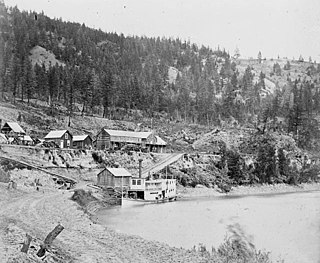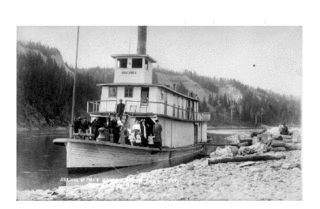Origin
On March 1, 1862, an advertisement ran in the Victoria Colonist that offered camels for sale with an address where interested parties could go for further information. The camels were being sold by a San Francisco merchant, Otto Esche, who was probably inspired by the use of dromedary camels by the US Army Camel Corps. These Bactrian camels had worked in Arizona for rail construction and Esche had used them as pack animals during the California Gold Rush. [1] [2]
The editor of the Colonist ran a headline stating "The Camels are Coming!" and with the vivacious journalism typical of the day added, "and after they have been disposed of, a number of trained whales will be placed on the route between Victoria and the Stikine River carrying freight and inside passengers a la Jonah". [1]
On March 15, the Colonist continued the story, reporting that Lillooet man, John Calbreath had purchased 23 of these animals for $300 a head and was planning to use them on the Old Cariboo Road to freight goods from Lillooet to Alexandria.
Calbreath was a representative of several other businessmen who were involved in this venture, Frank Laumeister, Adam Heffley and Henry Ingram. However, as the story unfolded, it was Laumeister whose name became the most associated with the Cariboo camels. Both Calbreath and Laumeister would later become involved in the Cassiar Gold Rush, owning stores and operating freighting businesses, although no camels would have any part of these ventures.
Arrival of camels
The camels arrived in Victoria on April 15 on the steamship Hermann. They were in the city and remained there until the 4th Day of May and were the subject of much local interest, as well as more headlines and editorials. One baby camel was born during their stay, and another escaped with its mother into the wilds of Vancouver Island and wouldn't be seen until that fall near Cadboro Bay. [3]
The others were loaded onto a barge and towed by William Moore's Flying Dutchman to New Westminster and on to Port Douglas. By the middle of May they were working on the Pemberton Portage on the Douglas Road. [4] BY May 24 they were on their way to Lillooet to work closer to the gold fields. [5]
At first, the camels seemed to be performing well. They could carry up to 500-600 pounds, which was twice what mules could carry, and they were good foragers. However, their soft feet were easily torn up by the harsh terrain of the Cariboo Road and canvas boots had to be made for them. [2]
By the end of June, the first camel train had left Lillooet for Alexandria and the papers reported that one camel was killed when it slid off a cliff into the Pavilion Creek. Soon more reports came in from the Cariboo, mostly complaints from the stagecoach drivers and the miners. Stage horses were terrified at the very sight of camels and even the best trained of them would bolt upon encountering the camels on the road. Furthermore, the camels' varied diet even included pants, shirts, hats and bars of soap.
One report mentioned Matthew Baillie Begbie's experience with the camel train and how his mount dashed off into the wilderness with the helpless judge clinging to the saddle. He would despise camels for the rest of his life. [4]
By October, the Colonist reported that a dozen camels had survived their first season and were wintering at Quesnel Forks.

The Cariboo Road was a project initiated in 1860 by the Governor of the Colony of British Columbia, James Douglas. It involved a feat of engineering stretching from Fort Yale to Barkerville, B.C. through extremely hazardous canyon territory in the Interior of British Columbia.

The Cariboo Gold Rush was a gold rush in the Colony of British Columbia, which later became the Canadian province of British Columbia. The first gold discovery was made at Hills Bar in 1858, followed by more strikes in 1859 on the Horsefly River, and on Keithley Creek and Antler Creek in 1860. The actual rush did not begin until 1861, when these discoveries were widely publicized. By 1865, following the strikes along Williams Creek, the rush was in full swing.

Seton Lake is a lake in the Squamish-Lillooet region of southwestern British Columbia. On the northeast side is Mission Ridge. On the southwest is the Cayoosh Range. By road, the eastern end is about 7 kilometres (4.3 mi) southwest of Lillooet.

The Camelsfoot Range is a sub-range of the Chilcotin Ranges subdivision of the Pacific Ranges of the Coast Mountains in British Columbia. The Fraser River forms its eastern boundary. The range is approximately 90 km at its maximum length and less than 30 km wide at its widest.

Barnard's Express, later known as the British Columbia Express Company or BX, was a pioneer transportation company that served the Cariboo and Fraser-Fort George regions in British Columbia, Canada from 1861 until 1921.
Soda Creek is a rural subdivision 38 km north of Williams Lake in British Columbia, Canada. Located on the east bank of the Fraser River, Soda Creek was originally the home of the Xat'sull First Nation. Soda Creek Indian Reserve No. 1 is located on the left (E) bank of the Fraser River, one mile south of the Soda Creek BCR (CN) station, 431.10 ha. 52°19′00″N122°16′00″W

Twelve paddlewheel steamboats plied the upper Fraser River in British Columbia from 1863 until 1921. They were used for a variety of purposes: working on railroad construction, delivering mail, promoting real estate in infant townsites and bringing settlers in to a new frontier. They served the towns of Quesnel, Barkerville and Fort George. Some only worked the Fraser from Soda Creek to Quesnel, while others went all the way to Tête Jaune Cache or took the Nechako River and served Fort Fraser and beyond.
The Old Cariboo Road is a reference to the original wagon road to the Cariboo gold fields in what is now the Canadian province of British Columbia. It should not be confused with the Cariboo Road, which was built slightly later and used a different route.

Owen Forrester Browne was a paddle steamer captain in British Columbia, and Alberta, Canada. He was born in New Westminster and worked on the lower Fraser and Yukon River sternwheelers before coming to the upper Fraser River in the early 1900s.

The Enterprise was a passenger and freight sternwheeler that was built for service on the Soda Creek to Quesnel route on the upper Fraser River in British Columbia. It was built at Four Mile Creek near Alexandria by pioneer shipbuilder James Trahey of Victoria for Gustavus Blin Wright and Captain Thomas Wright and was put into service in the spring of 1863. Her captain was JW Doane. The Enterprise was the first of twelve sternwheelers that would work on this section of the Fraser from 1863 to 1921. Though she was not large, she was a wonderful example of the early craft of shipbuilding. All of the lumber she was built from was cut by hand and her boiler and engines had been brought to the building site at Four Mile packed by mule via the wagon road from Port Douglas, 300 miles away.
Victoria was a passenger and freight sternwheeler that was built for service on the Soda Creek to Quesnel route on the upper Fraser River in British Columbia. She was built at Quesnel by pioneer shipbuilder James Trahey of Victoria for Gustavus Blin-Wright and Captain Thomas Wright and was put into service in the spring of 1869 to augment the service of Enterprise also built by Trahey for the Wrights. Although the Victoria's hull was new, her engines and boiler had originally been in the Prince of Wales from Lillooet Lake.

Quesnel was a sternwheeler first launched in May 1909 at Quesnel, British Columbia to serve the Soda Creek to Fort George route of the upper Fraser River.

The Fort Fraser was a small sternwheeler owned by the Fort George Lumber and Transportation Company a partnership originally held by Nick Clarke and Russell Peden from the Fort George town-site of South Fort George. The Fort Fraser was intended to be a small prospecting craft that could service not only the Soda Creek to Fort George section of the upper Fraser River but also the Nechako River and some of its tributaries, enabling her to serve her namesake town of Fort Fraser.

The sternwheeler Chilcotin was built for the Soda Creek to Fort George route of the upper Fraser River. She was built by shipbuilder Donald McPhee for the Fort George Lumber and Navigation Company, which was a partnership held by Nick Clarke and Russell Peden of the South Fort George town-site of Fort George. Chilcotin was the largest of the company's three sternwheelers and was intended to run as competition against the BC Express Company's new luxury sternwheeler, BX. Chilcotin had main, promenade and Texas decks, hot and cold running water and stateroom accommodation for fifty.

The Robert C Hammond was the last sternwheeler built for service on the upper Fraser and Nechako Rivers. She was owned by the Fort George Lake and River Transportation Company, a partnership of George Hammond and his brother. She was launched at the Central Fort George town-site of Fort George on May 22, 1913. She was built so that George Hammond, the promoter of Central Fort George, could claim that his community had steamer service. Central Fort George was on the Nechako River and the large sternwheelers owned by the BC Express Company, despite a $50 per trip inducement, could rarely call there, as there often were sandbars unless the water was very high. The rival sternwheelers of the South Fort George town-site owned by the Fort George Lumber and Navigation Company were not interested in helping George Hammond promote Central.

The Conveyor was one of five sternwheelers built for the use on the Skeena River by Foley, Welch and Stewart for construction work on the Grand Trunk Pacific Railway. The other four were the Operator, the Skeena, the Distributor and the Omineca. Three of these, the Conveyor, the Operator and the Distributor were built at Victoria, British Columbia in 1908 by Alexander Watson Jr.

The Operator sternwheeler was one of five sternwheelers built for the use on the Skeena River by Foley, Welch and Stewart for construction work on the Grand Trunk Pacific Railway. The other four were the Conveyor, the Skeena, the Distributor and the Omineca. Three of these, the Conveyor, the Operator and the Distributor were built at Victoria, British Columbia, in 1908 by Alexander Watson Jr.

Gustavus Blin Wright was a pioneer roadbuilder and entrepreneur in British Columbia, Canada. His biggest achievement was building the Old Cariboo Road to the Cariboo gold fields, from Lillooet to Fort Alexandria, but he was also a partner in a freighting firm that operated on the Douglas Road, he ran a toll bridge at Bridge River, near Lillooet, and built part of the road from Quesnel to Barkerville. He was also the original owner of the town of 70 Mile House.

Stephen Tingley was a stagecoach driver and one of the original owners of the pioneer transportation company BC Express that served the Cariboo region in British Columbia, Canada for 60 years, from 1860, when it was first founded as Barnard's Express, until 1920, when it ceased its sternwheeler service.

William Irving was a steamship captain and entrepreneur in Oregon, US and British Columbia, Canada. The Irvington neighborhood in Portland, Oregon, is named in his honor and in New Westminster, British Columbia, his home, "Irving House", is now a heritage site. He was one of the earliest pioneers of steamer travel in the Pacific Northwest and is remembered as one of the most successful and popular captains of the era.

















